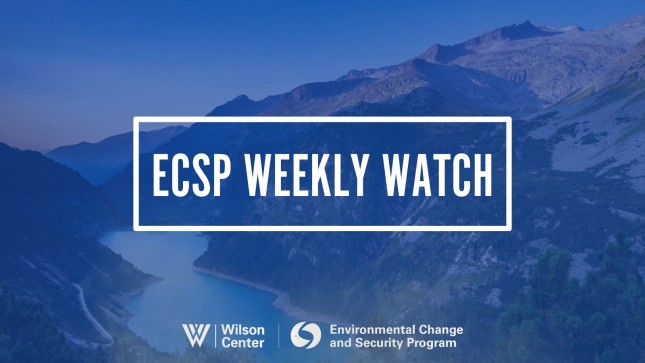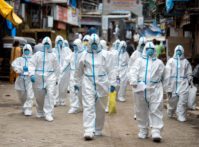-
ECSP Weekly Watch | August 12 – 16
August 16, 2024 By Neeraja Kulkarni
A window into what we are reading at the Wilson Center’s Environmental Change and Security Program
Mpox Outbreak a Global Health Emergency, Again (The Washington Post)
Various rapidly spreading mpox strains in Central and East African countries have led the World Health Organization (WHO) to declare the viral infection as a global health emergency. More than 15,000 people have been infected this year alone, with over 500 deaths reported. Mpox is transmitted largely through exposure to infected animals, as well as via skin-to-skin or sexual contact, and it disproportionately affects heterosexuals and sex workers.
Most cases in the latest outbreak have concentrated in the DRC, where 13,000 people have been affected. Children in that nation who are already exposed to malaria and malnourishment are now battling a new health problem. The displacement of millions of DRC residents because of the ongoing conflict in eastern regions of the DRC has exacerbated the crisis, raising concerns about the effectiveness of health response efforts.
Experts are highlighting the need to reduce mpox spread in health centers by providing protective equipment, and disinfectants, and ramping up vaccinations. And the WHO’s announcement will mobilize international funds to mitigate the crisis with greater urgency at its stem. In the past week, efforts have been underway to supply vaccines to international organizations and accelerate access in countries where mpox vaccines are not licensed. Critics also point to the revived emergency declaration after a similar declaration two years ago as evidence of an inadequate global response in addressing well-established infectious threats in low-developing countries.
READ | New Global Health & Gender Policy Brief: Climate Change and Maternal and Newborn Health Outcomes
Extreme Heat Undermines Global Education (The New York Times)
As nations from Pakistan, South Sudan, and the Philippines, to Bangladesh, Honduras, and Palestine face record-breaking extreme weather events this year, this heat and flooding has also closed schools for days, or even weeks. Climate-vulnerable and low to middle-income countries are especially vulnerable to the challenges extreme weather events pose to educational access.
Since most school shutdowns are local and regional, there is still no comprehensive global data on school closure days resulting from extreme weather. In recent remarks, however, UN Secretary-General António Guterres stressed that at least 80 million children were absent from schools in 2024 because of extreme heat. Researchers also have found that heat hampers learning outcomes, with a demonstrable impact on children’s test scores, which may have a strong correlation with heat-related absences.
While the quality of schooling, enrollments, and literacy rates have improved over the past decade, a pandemic, a series of wars, and other adverse events mean that the number of children denied access to schools over significant periods of time is rising. Thus, assessing and accounting for the role of climate shocks in undermining or stagnating education progress becomes essential—especially since extreme weather events are expected to worsen in coming years. Experts suggest one remedy is to build heat-resilient adaptation mechanisms into schools to ensure continued student access to education.
READ | Climate Change and Children’s Mobility
Are We Ready for Greener Concrete? (The Guardian)
Cement manufacturing contributes to 8% of global CO2 emissions. So with the advent of a worldwide push for greener materials, manufacturers now seek to update their supply chains via the use of cleaner fuels and reuse of industrial waste. The challenge? Fully 60% of emissions are derived from the chemical processes that result from manufacturing.
A groundbreaking Heidelberg Materials system that begins operation this year is set to change the financial landscape of carbon capture and storage (CCS) technologies in ways that may help resolve this issue. Heidelberg Materials is the first of very few facilities that aims to trap 90% of carbon emissions in cement production, and then ship, pipe, and pump that carbon 2.5km beneath the Norwegian seabed as a part of that nation’s Northern Lights project.
Norway’s ”Longship” agenda to build the world’s first cross-border carbon capture and storage infrastructure shows how important the role of political will can be in advancing such technologies. Yet the Heidelberg Materials project still faces a few hurdles, including broader unpredictability both in global carbon prices and risks associated with them. Proponents also have concerns about how the market will respond to alternative materials and carbon-free cement premium prices. Green advocates also are divided on the issue. Some groups support the advent of such emerging technologies, while others see them as a greenwashing tool that obscures the overall effectiveness of emission reductions.
READ | The Crushing Environmental Impact of China’s Cement Industry
Sources: The Washington Post, The New York Times, The Guardian, CBS News, CCS Norway, World Meteorological Organization (WMO), Al Jazeera, World Health Organization (WHO)
Topics: adolescent health, Africa, carbon, circular economy, climate, climate change, conflict, decarbonization, education, energy, extreme weather, Eye On, health systems, humanitarian, Infrastructure, meta, Norway, population, poverty, sanitation, security, sexual and reproductive health, transportation, urbanization
 A Publication of the Stimson Center.
A Publication of the Stimson Center.







